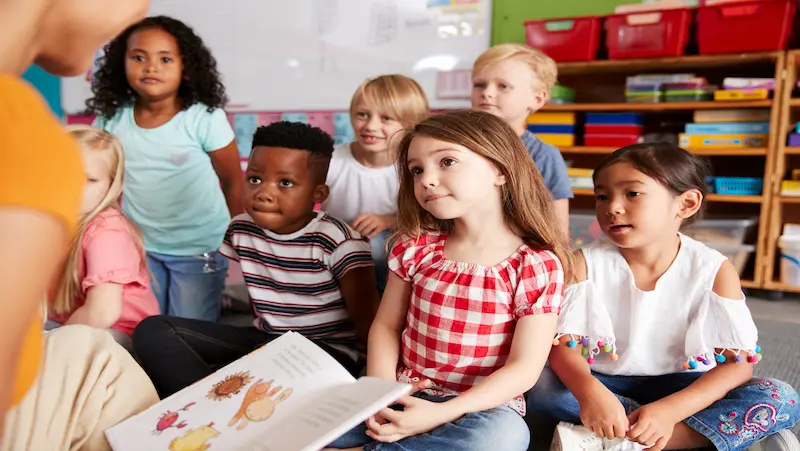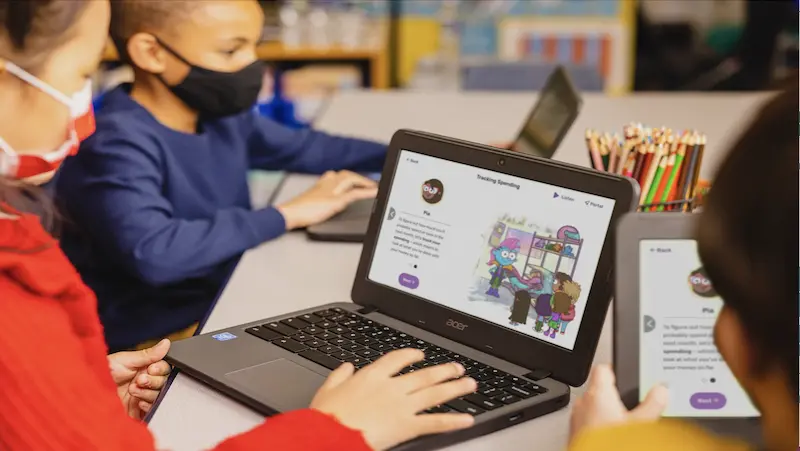In the journey of learning, literacy stands as a guiding light for young minds in elementary education. Imagine a world where words are mysterious codes and stories remain locked away. Literacy opens the doors to this magical realm, empowering children to read, write, and express themselves. It’s more than just deciphering letters; it’s the key to unlocking knowledge, fostering imagination, and building a strong foundation for a lifetime of learning. In elementary education, literacy isn’t just a subject—it’s the bridge that connects a child to the vast world of ideas and possibilities.
Table of contents
Understanding the Basics
In the grand story of learning, literacy is the hero that unlocks the magic of words and ideas. Let’s take a stroll through the enchanted forest of language and discover the four key pillars that make literacy a powerful spell.

Reading: Unraveling the Treasure Chest of Words
Imagine reading as a treasure hunt for words. When we read, we decode symbols on paper or screen, transforming them into stories, information, and adventures. It’s like having a map to explore new lands and ideas.
Writing: Crafting Your Own Fairy Tale
Now, let’s pick up our pens and pencils to become wizards of words ourselves. Writing is the art of expressing thoughts and feelings on paper. It’s creating your own magical kingdom of ideas, where you are the ruler and words are your loyal subjects.
Listening: The Dance of Words in the Air
In the symphony of literacy, listening is the graceful dance of words in the air. When someone speaks, we tune in with our ears, catching the rhythm and melody of the language. It’s like enjoying a beautiful song, but instead of notes, we catch words that paint pictures in our minds.
Speaking: Casting Spells with Words
Now, let’s become wizards of the spoken word. Speaking is the magic spell that brings words to life. Whether it’s telling a tale, sharing a joke, or asking a question, speaking is how we connect with others and make our voices heard in the world.
Identifying Individual Needs

Diverse Learning Styles:
Elementary students are like a bouquet of flowers, each one distinct in their own way. Some kids are visual learners, absorbing information best through pictures and diagrams. They thrive when presented with colorful visuals and graphics. On the other hand, there are tactile learners who learn by doing. These hands-on enthusiasts grasp concepts more effectively through activities and interactive experiences. Auditory learners, meanwhile, are the listeners of the class, benefiting most from spoken words, discussions, and even music.
Understanding these varied learning styles is like having a secret decoder for unlocking each child’s potential. By recognizing how they learn best, we can tailor our teaching methods to match their unique preferences, making learning more engaging and enjoyable.
Tips on Identifying Literacy Needs:
Observation is Key:
Spend time observing your students during different activities. Take note of how they respond to various tasks, whether it’s reading, writing, or group activities. Are they more engaged when reading aloud, or do they prefer silent reading? Observe their body language and reactions.
One-on-One Conversations:
Have individual conversations with your students. Ask them about their favorite books, topics, and how they feel about reading and writing. Understanding their interests and attitudes towards literacy can provide valuable insights into their needs.
Assessment Tools:
Use a variety of assessment tools to gauge their literacy skills. This could include simple quizzes, reading comprehension exercises, or writing prompts. These tools help identify specific areas where a student may need extra support.
Parental Involvement:
Reach out to parents or guardians for their input. They can provide valuable information about a child’s reading habits at home, any challenges they may be facing, or even share insights into the child’s preferred learning style.
Collaboration with Peers:
Encourage peer collaboration and feedback. Sometimes, students can pick up on things that adults might miss. Group fun money activities and discussions can reveal how students interact with literacy tasks and how they support each other.
Reading Aloud with Expression
When it comes to reading, it’s not just about the words on the page. Imagine a story coming to life, where every character has a unique voice, and emotions dance through the sentences. That’s the magic of reading aloud with expression. In this blog post, we’ll explore how to inspire students to read with feeling and the incredible benefits it brings to their comprehension skills.

Encouraging Expression:
1. Use Engaging Texts:
Start with stories that captivate the imagination. Whether it’s a thrilling adventure or a heartwarming tale, a good story naturally lends itself to expressive reading.
2. Model Expressive Reading:
Be the reading role model! Demonstrate how to infuse excitement, curiosity, or sadness into the words. Your enthusiasm is contagious and will encourage students to follow suit.
3. Expressive Reading Games:
Turn reading into a game. Assign different emotions to characters or scenes and ask students to read accordingly. This not only makes reading fun but also helps them grasp the emotional tone of the text.
Benefits of Expressive Reading:
1. Improved Comprehension:
Expressive reading isn’t just about sounding good; it enhances understanding. When students read with emotion, they connect with the material on a deeper level, making it easier to grasp the meaning behind the words.
2. Vocabulary Development:
By reading with expression, students naturally explore the nuances of language. They become familiar with different tones, intonations, and emotions, expanding their vocabulary and language skills.
3. Enhanced Retention:
Emotions are powerful memory enhancers. When students infuse feeling into their reading, it creates memorable associations, leading to better retention of information.
Collaborative Writing Projects

Benefits of Group Writing:
1. Idea Playground: When you write with others, your ideas get a chance to mingle with diverse perspectives. It’s like a brainstorming bonanza where creativity knows no bounds.
2. Learning from Peers: Every team member brings a unique set of skills to the table. Collaborative writing lets you learn from others, picking up new words and sentence structures like treasures on a shared adventure.
3. Building Confidence: Writing in a group setting can boost confidence. Knowing that your words are part of a collective masterpiece can be a powerful motivator, making you more eager to contribute.
4. Problem Solving: Writing together teaches the art of compromise and problem-solving. When ideas clash, the team works together to find a solution, creating a rich learning money activities experience.
Examples of Collaborative Projects:
1. Round-Robin Storytelling: Each person in the group contributes a sentence or paragraph to build a story. It’s like a literary relay race where creativity is passed from one teammate to another.
2. Shared Blogs or Journals: Create a blog or journal that multiple people contribute to regularly. This way, you get a mix of voices and styles, creating a dynamic and engaging reading experience.
3. Collaborative Poetry: Write poems as a team, with each member contributing lines or stanzas. It’s a poetic symphony where words blend into a harmonious masterpiece.
4. Interactive Fiction: Craft a story where each team member is responsible for a different branch or decision point. Readers can then choose different paths, turning the narrative into an interactive adventure.
Effective Listening and Speaking
We get it – the thought of standing in front of a crowd, and sharing your thoughts aloud, can be nerve-wracking. But fear not! Mastering the art of oral presentations is all about confidence and a sprinkle of active listening magic.

1. Embrace Your Uniqueness:
First things first, remember that your voice is like a fingerprint – it’s uniquely yours. Embrace it! Practice speaking in front of a mirror to get comfortable with the sound and cadence of your own voice. The more you hear it, the more confident you’ll become.
2. Know Your Stuff:
Confidence comes from knowledge. Before your presentation, make sure you know your material inside out. Familiarize yourself with key points so well that you could chat about them over coffee. This way, even if nerves kick in, your expertise will shine through.
3. Practice, Practice, Practice:
Repetition is your friend. Practice your presentation multiple times, preferably in front of a friend or family member. Their feedback can be gold, helping you refine your delivery and identify areas for improvement.
4. Slow Down and Breathe:
When nervous, it’s easy to speed up your speech. Fight that urge! Take deep breaths and consciously slow down your pace. This not only makes you sound more composed but also gives your audience time to absorb your words.
Active Listening: The Secret Sauce
Now, let’s talk about active listening – the unsung hero of excellent speaking skills.
1. Tune In to Others:
To be a great speaker, you must first be a great listener. Pay attention when others speak. Listen not just to their words, but also to their tone, pace, and pauses. This will sharpen your own speaking skills by making you more aware of the nuances of effective communication.
2. Learn from the Pros:
Watch and learn from skilled speakers. Observe how they modulate their voices, engage the audience, and maintain eye contact. Pick up tips and tricks that resonate with you, and incorporate them into your own style.
3. Respond Thoughtfully:
When engaging in conversations, respond thoughtfully. This not only shows respect to the speaker but also hones your ability to articulate ideas on the spot. The more you practice, the more natural and confident you’ll become in your own presentations.
Role-playing for Effective Communication

Listening with Intent
In the art of conversation, listening is just as important as speaking. Role-playing encourages active listening, as participants must tune in to each other’s cues to navigate the scenario. It’s not just about hearing words; it’s about understanding the underlying emotions and perspectives.
Imagine a scenario where you’re playing the role of a friend trying to console someone who’s upset. Your partner takes on the role of the distressed friend. As you embody this character, you’re compelled to listen closely, picking up on subtle cues and responding empathetically. This type of engagement enhances your ability to truly hear and comprehend, fostering a deeper connection.
Speaking with Confidence
Role-playing also hones your speaking skills. It’s a safe space to practice articulating thoughts, expressing feelings, and even negotiating. When you embody a role, you step into the shoes of someone else, temporarily shedding inhibitions. This freedom allows you to experiment with different communication styles and discover what works best for you.
Consider a scenario where you’re practicing a job interview with a friend. You take turns being the interviewer and interviewee. This not only helps you refine your answers but also boosts your confidence. The more you inhabit different roles, the more versatile and effective your communication becomes.
Scenarios that Spark Connection
Effective role-playing scenarios are rooted in real-life situations. Everyday scenarios, like resolving a disagreement, asking for help, or giving constructive feedback, provide a practical platform for skill-building. These scenarios mirror situations you encounter regularly, making the skills acquired in role-playing immediately applicable to your daily life.
Picture a scenario where you and a friend role-play negotiating a compromise. This exercise not only sharpens your negotiation skills but also fosters teamwork and understanding. These scenarios serve as mini-life simulations, preparing you for various communication challenges.
Technology Integration
In the fast-paced digital age, educational apps and online platforms have become valuable tools in shaping young minds. When it comes to literacy, these tech-savvy solutions offer engaging ways for childrens financial literacy to develop essential reading and writing skills.

Unlocking Learning with Apps:
Imagine a world where learning feels like play – that’s what literacy-focused apps bring to the table. From interactive storybooks to games that make words come alive, these apps make the journey to literacy exciting. They cater to various age groups, ensuring that every child finds a virtual companion in their learning adventure.
Online Platforms: A Digital Classroom at Your Fingertips:
Online platforms extend learning beyond apps. They provide a space for kids to connect with teachers and peers, fostering a sense of community. Reading exercises, writing prompts, and collaborative projects create an immersive environment for young learners.
Cautionary Notes on Screen Time:
While these educational tools are fantastic, a word of caution is in order – balance is key. Too much screen time can be like having too many cookies; it might be fun at first, but it’s not healthy in the long run. Parents and caregivers should ensure that these digital learning experiences complement, not replace, other essential activities like outdoor play and face-to-face interactions.
Striking the Right Balance:
Encouraging a healthy relationship with technology involves setting reasonable time limits for screen use. A good rule of thumb is the 20-20-20 rule: for every 20 minutes of screen time, take a 20-second break and look at something 20 feet away. This helps reduce eye strain and keeps young minds fresh and focused.
Conclusion
In wrapping up, it’s crystal clear that tailoring lesson plans to fit the specific needs of students is absolutely crucial. Just like people have different fingerprints, students have varied learning styles, strengths, and challenges. Adapting our teaching children about finances approach ensures that each student gets a fair shot at understanding and thriving. It’s not about a one-size-fits-all; it’s about recognizing the uniqueness of each learner and adjusting our lessons accordingly. Ultimately, by embracing this adaptability, we’re not just teaching subjects; we’re nurturing individuals on their unique educational journey.
To get your hands on more such articles, educational content, and free resources on coding for kids, robotics courses, game development, etc., check out the BrightCHAMPS Blog Page now!
Frequently Asked Questions
A1. Kids and teens find financial planning interesting because it helps them understand real-life money situations, like saving for things they want or making smart spending choices. It’s like a cool game that teaches important life skills!
A2. Absolutely! Use fun activities like setting up a pretend store, creating a “money diary,” or playing budgeting games. This makes learning about money feel like an adventure instead of a boring class.
A3. By managing their own money, kids learn responsibility. Whether it’s saving for a toy or deciding how to spend their allowance, these activities show them that choices have consequences, helping them become responsible money managers.
A4. Yes! For little ones, picture books like “Bunny Money” work great. Teens might benefit from online games or apps like “iAllowance” to grasp more complex financial concepts.
A5. They prepare kids for life by teaching skills like budgeting, saving, and making wise choices with money. It’s like giving them a head start on being smart with their finances when they’re older.
A6. Sure! For younger kids, try a “money jar” for saving coins. Teens could create a simple budget for a week, planning how much to spend on different things. Hands-on exercises make learning about money practical and fun!


 We are an army of educators and passionate learners from BrightChamps family, committed to providing free learning resources to kids, parents & students.
We are an army of educators and passionate learners from BrightChamps family, committed to providing free learning resources to kids, parents & students.








